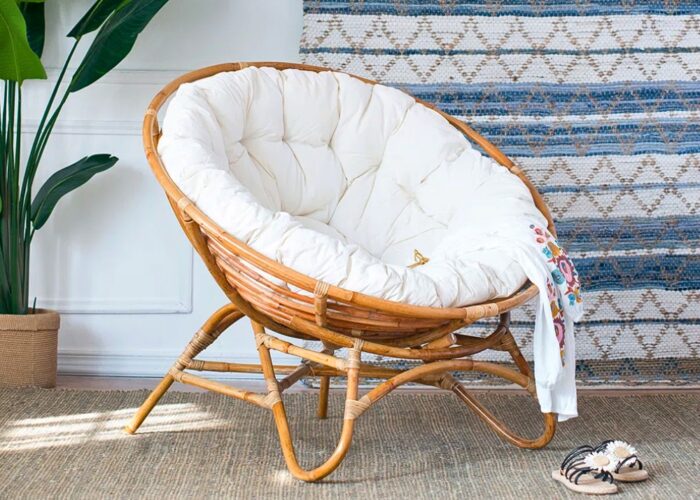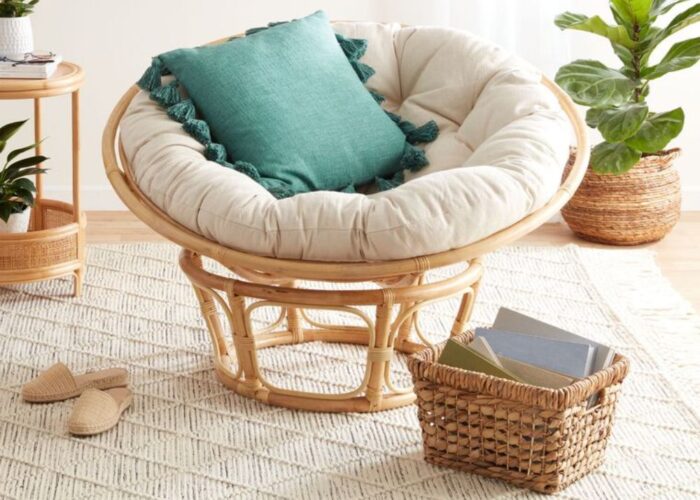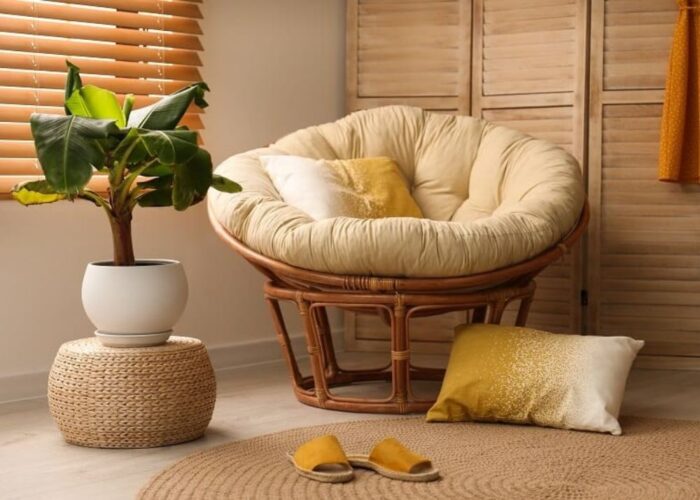Papasan chairs, with their unique design and comfort, have become a beloved piece of furniture in many homes. However, a common issue that users often encounter is the chair’s tendency to slide on the floor, causing noise and compromising comfort. To address this problem, there are several simple solutions you can apply. This article will guide you on how to keep a papasan chair from sliding, ensuring safety and enhancing stability for your ideal sitting experience.
Contents
1. Common issues with papasan chairs sliding
Papasan chairs are renowned for their comfort and unique design, but they can present a few common issues, particularly regarding sliding. Here are some of the common issues with papasan chairs sliding:
- Floor Surface: One of the primary reasons for papasan chairs sliding is the type of floor surface they’re placed on. Smooth surfaces like hardwood or tiles offer less friction, making it easier for the chair to slide around.

- Chair Design: While the wide, round base of papasan chairs contributes to their stability, it can also lead to sliding, especially if the chair is bumped or moved frequently.
- Weight Distribution: Uneven weight distribution or excessive movement while sitting can cause the papasan chair to shift and slide on the floor.
- Lack of Grips or Pads: Papasan chairs typically do not come with grips or pads on the base, which could help prevent sliding on smooth surfaces.
- Worn-out Base: Over time, the base of the papasan chair may wear out, reducing its grip on the floor and making it more prone to sliding.
- Environmental Factors: Environmental factors such as humidity or temperature changes can affect the friction between the chair base and the floor, contributing to sliding.
2. How to keep the papasan chair from sliding?
Keeping a papasan chair from sliding can enhance both its safety and comfort. Here are some effective methods to prevent a papasan chair from sliding:
- Non-Slip Pads or Gripper Strips: Place non-slip pads or gripper strips under the base of the papasan chair. These adhesive pads provide traction and prevent the chair from sliding on smooth surfaces like hardwood floors or tiles.
- Rug or Carpet Underlay: Position a rug or carpet underlay beneath the papasan chair. The texture of the rug or carpet helps grip the chair’s base, reducing the likelihood of sliding.
- Rubber Feet or Caps: Attach rubber feet or caps to the bottom of the chair’s legs. These rubber attachments increase friction between the chair and the floor, minimizing movement and preventing sliding.

- Velcro Strips: Affix Velcro strips to both the chair’s base and the floor. When pressed together, Velcro provides a strong grip, effectively anchoring the chair in place and preventing sliding.
- Adjust Positioning: Place the papasan chair against a wall or furniture piece to stabilize it and prevent sliding. Alternatively, position the chair in a corner to minimize movement.
- Weight Distribution: Encourage proper weight distribution while seated in the papasan chair. Avoid sudden movements or shifts in position, as these can cause the chair to slide.
- Regular Maintenance: Inspect the chair’s base regularly for signs of wear and tear. Replace worn-out or damaged components to maintain optimal grip and stability.
By implementing these strategies, you can effectively prevent your papasan chair from sliding, ensuring a safe and comfortable seating experience.
3. Additional tips for chair stability
Ensuring the stability of your papasan chair is essential for both safety and comfort. Here are some additional tips to enhance chair stability:
Regular Maintenance Practices for Papasan Chairs
Regular maintenance is crucial for preserving the longevity and performance of your papasan chair. Here are some recommended maintenance practices:
- Cleaning: Regularly wipe down the chair’s frame, cushion, and other components to remove dust, dirt, and debris. Use a mild detergent and water solution for cleaning, avoiding harsh chemicals that may damage the material.
- Cushion Flipping: Rotate and flip the chair’s cushion periodically to promote even wear and prevent sagging. This helps maintain the cushion’s shape and comfort level over time, ensuring consistent support for the user.

- Frame Inspection: Regularly check the chair’s frame for any signs of damage, such as cracks, splinters, or warping. Address any issues promptly to prevent further deterioration and ensure structural integrity.
- Fastener Tightening: Inspect the chair’s fasteners, including screws, bolts, and nuts, and tighten them as needed. Loose fasteners can compromise the chair’s stability and safety, so ensuring they are secure is essential.
- Weather Protection: If you use the chair outdoors, protect it from prolonged exposure to harsh weather conditions, such as rain, sunlight, and humidity. Consider storing the chair indoors when not in use or using weatherproof covers to prevent damage from the elements.
Checking for Signs of Wear and Tear
Regularly checking for signs of wear and tear can help identify potential issues early and prevent accidents or injuries. Here’s what to look out for:
- Fabric Condition: Inspect the chair’s cushion and upholstery for any tears, fraying, or fading. Address minor damage promptly to prevent it from worsening.
- Frame Integrity: Check the chair’s frame for structural damage, such as cracks, dents, or bent components. Any compromised areas should be repaired or reinforced immediately.
- Stability Test: Periodically test the chair’s stability by gently rocking it from side to side and front to back. If you notice excessive wobbling or instability, investigate the cause and address it accordingly.
- Fastener Inspection: Ensure all fasteners, including screws, bolts, and nuts, are securely tightened. Replace any missing or damaged fasteners promptly.
- Cushion Support: Assess the cushion’s support and comfort level. If it feels uneven or flattened, consider adding additional padding or replacing the cushion altogether.
By implementing these maintenance practices and regularly checking for signs of wear and tear, you can ensure your papasan chair remains stable, safe, and comfortable for years to come
4. FAQs
4.1 How much weight can a wicker papasan chair hold?
The weight capacity of a wicker papasan chair can vary depending on its design and construction. However, most standard wicker papasan chairs are designed to hold an average weight capacity of around 250 to 300 pounds. It’s essential to check the manufacturer’s specifications for the specific chair you have to ensure it can safely support your weight. Exceeding the recommended weight limit can compromise the chair’s structural integrity and pose a safety risk.
4.2 How do I choose the right non-slip pads for my papasan chair?
Choosing the right non-slip pads for your papasan chair involves considering the material, size, and the specific needs of your chair and flooring. Rubber non-slip pads are a popular choice due to their grip and durability. Measure the base of your papasan chair to ensure the pad covers the entire area without overhanging edges. Additionally, consider the thickness of the pad; a thicker pad can provide more cushioning and stability. For hardwood floors, a pad with a felt layer on top of the rubber may offer additional protection against scratches.
4.3 Can I use adhesive-backed Velcro strips to prevent my papasan chair from sliding?
Using Velcro strips with adhesive backing is a smart solution to prevent your papasan chair from sliding. This method is not only simple but also effective, as Velcro can create the necessary friction force to keep the chair in place without damaging the floor surface or the chair base. You can attach one side of the Velcro strip to the base of the chair and the other side to the underside of the cushion. Ensure that the contact surface is clean and dry before applying to make the Velcro stick more securely. If you need a more long-term solution, you can sew a piece of Velcro onto both the cushion and the chair, creating a stronger bond that can be detached when needed.
If you have any further questions, don’t hesitate to send thanhcongcraft an email us at info@thanhcongcraft.com or message us at WhatsApp: +84967485411. Hope to serve you soon! Best regard!












